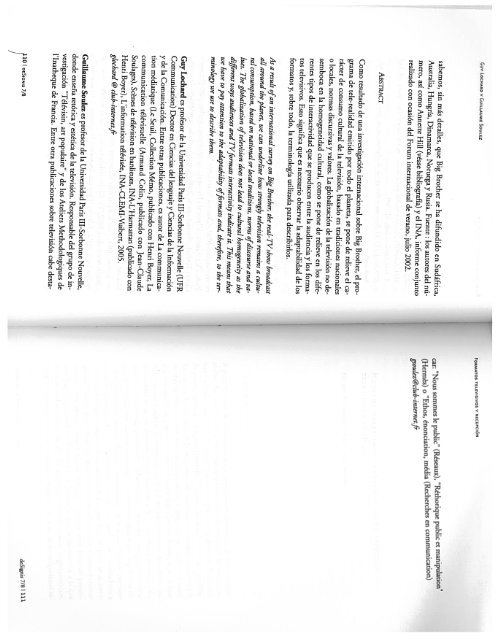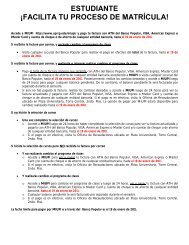FORMATOS DE LA TELEVISION / /
FORMATOS DE LA TELEVISION / /
FORMATOS DE LA TELEVISION / /
You also want an ePaper? Increase the reach of your titles
YUMPU automatically turns print PDFs into web optimized ePapers that Google loves.
110 I <strong>DE</strong>SIGNIS 7/8<br />
cleSignis 718 111<br />
lInatheque de Francia. Entre otra publicaciones sobre televisiOn cabe desta<br />
vestigaciOn “Télévisin, art populaire” y de los Ateliers Methodologiques de<br />
donde enseña retórica y estética de la televisiOn. Responsable del grupo de in<br />
Guillaume Soulez es profesor de la Universidad Paris Ill-Sorbonne Nouvelle,<br />
glochard @ club-internet.fr<br />
Henri Boyer), L’information télévisée, INA-CLEMI-Vuibert, 2005.<br />
Soulages), Scenes de télévision en banlieues, INA-L’Harmattan (publicado con<br />
communication télévisuelle (Armand Cohn, publicado con Jean-Claude<br />
tion mediatique (Le Seuil, Collection Memo, publicado con Henri Boyer, La<br />
y de la Comunicación. Entre otras publicaciones, es autor de La communica<br />
Communication) Doctor en Ciencias del lenguaje y Ciencias de Ia Información<br />
Guy Locha.rd es profesor de la Universidad Paris Ill-Sorbonne Nouvelle (UFR<br />
minology we use to describe them.<br />
we have to pay attention to the adaptability offormats and, therefore, to the ter<br />
different ways audiences and TVformats interactivity indicate it. This means that<br />
lues. The globalization oftelevision does not lead to cultural homogeneity as the<br />
ral consumption, based on national or local traditions, norms ofdiscourse and va<br />
all around the planet, we can underline how strongly television remains a cultu<br />
As a result ofan international survey on Big Brother, the real- TI/show broadcast<br />
formatos y, sobre todo, la terminologla utilizada para describirlos.<br />
tos televisivos. Esto significa que es necesario observar la adaptabilidad de los<br />
rentes tipos de interactividad que se producen entre la audiencia y los forma<br />
semboca en Ia homogeneidad cultural, como Se pone de relieve en los dife<br />
o locales, normas discursivas y valores. La globalizaciOn de la televisiOn no de<br />
rácter de consumo cultural de la television, basado en tradiciones nacionales<br />
grama de tele-realidad emitido por todo el planeta, Se pone de relieve el Ca<br />
Como resultado de una investigación internacional sobre Big Brother, el pro<br />
ABSTRACT<br />
realizado con ocasión del Forum internacional de verano, julio 2002.<br />
mero, asI como Annette Hill (véase bibliografla) y el INA, informe conjunto gsoulez@club_internet.fr<br />
Australia, HungrIa, Dinamarca, Noruega y Rusia. Fuente: los autores del nü- (Hermes) o “Ethos, énonciation, media (Recherches en communication<br />
sabemos, sin más detalles, que Big Brother se ha difundido en Sudáfrica, c: “Nous sommes le public’ (Réseac), “Rethorique public et manipulation’<br />
Guy LOCHARD v GUIL<strong>LA</strong>UME SOULEZ <strong>FORMATOS</strong> TELEVISIVOS V RECEPCION



